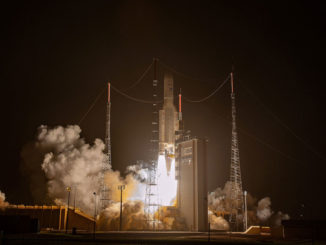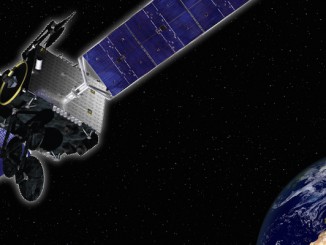
CAPE CANAVERAL — Assembly of a 19-story Atlas rocket started today for a commercial launch next month to aid Mexico’s telecommunications reform aimed at economic growth and the betterment of its societal welfare.
The United Launch Alliance Atlas 5 rocket began to take shape at the Vertical Integration Facility, located adjacent to the pad at Cape Canaveral’s Complex 41.
Stacking kicked off less than two weeks after the last Atlas launch, which occurred Sept. 2 to successfully deliver a U.S. Navy mobile communications satellite into orbit.
The predawn launch of the Morelos 3 geosynchronous mobile communications satellite is targeted for Oct. 2 during a 20-minute window running from 6:08 to 6:28 a.m. EDT (1008-1028 GMT).
Morelos 3 completes the Mexican Satellite System (MEXSAT) to bring broadband communications to remote areas of the country.
“Mexico is performing significant investments in a satellite system infrastructure project called the MEXSAT. The reform contemplates its role as one of the essential instruments to boost the development of telecommunications in benefit of all Mexicans,” said Gerardo Ruiz Esparza, Mexico’s minister of communications and transportation.
“This administration knows Mexico needs a solid, long-term satellite public policy with modern technologies and strong social orientation. This is precisely what this (MEXSAT) program is about.”
The $1.6 billion MEXSAT program hasn’t unfolded cleanly, however. A duplicate spacecraft to Morelos 3, dubbed the Centenario satellite, was destroyed in May by the failed launch of a Russian Proton rocket.
Boeing built both geomobile satellites in El Segundo, California, to provide voice, data relay and Internet connectivity.
The system will assist disaster relief, emergency services, telemedicine, rural education and government agency operations.
“The new MEXSAT system…will provide communications services to remote communities with difficult access, reducing the digital divide,” said Esparza.
The first element of the MEXSAT project was launched by an Ariane 5 rocket in 2012 to provide video services. It is a small, Orbital ATK-built satellite.
The stacking work for AV-059 began this morning as the bronze-colored, 106.6-foot-long, 12.5-foot-diameter first stage was pulled to the VIF doorway, erected upright and hoisted inside the building to be put aboard the mobile launcher platform.
Known as the Common Core Booster, the stage produces 860,000 pounds of thrust to lift the rocket off the ground. It burns kerosene fuel and supercold liquid oxygen during the initial minutes of flight.
In the coming days, two strap-on boosters will be added, along with the barrel-like interstage adapter and the Centaur upper stage. Centaur is 41.5 feet in length, 10 feet in diameter and is fueled by liquid hydrogen and liquid oxygen.
The payload is undergoing its own processing in nearby Titusville at the Astrotech facility. It will be delivered to the VIF and mated to the Atlas-Centaur in late September.
The rocket, delivering 1.5 million pounds of liftoff thrust, will be flying in the 421-variant that features an RD-180 main engine powering the first stage, a pair of strap-on solid-fuel boosters and an RL10 on the Centaur upper stage. The satellite will be enclosed in a 14-foot-diameter aluminum nose cone for atmospheric ascent.
Morelos 3 is destined for geosynchronous orbit 22,300 miles high.
The launch will be the 57th Atlas 5 rocket since 2002 and its 12th commercial flight. For United Launch Alliance, it is the company’s 100th launch overall since 2006 and the ninth this year.
Our Atlas archive.



